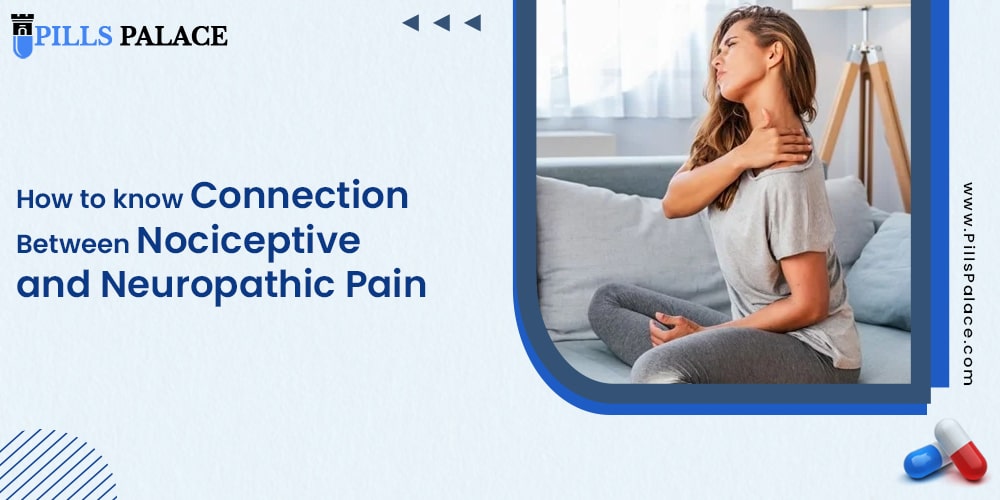How to know Connection Between Nociceptive and Neuropathic Pain
Nociceptive pain is a kind of muscle pain caused by injuries of accidents and unwanted happenings. A sports injury, a dental operation, or arthritis are all examples of pain.
Neuropathic pain develops when nerves in the peripheral nervous system or the central nervous system are damaged. As a result, they begin to elicit discomfort, which can be difficult to distinguish from unpleasant pain. At the location of neurological damage, sodium channels are increased. Infections in the inured region, diabetic neuropathy, and various procedures can all cause this damage.
What Are Nociceptors and What Do They Do?
Nociceptors describe the pain due to muscle retentions or tissue injuries.
Treatment
Nociceptive pain is treated differently depending on the kind of damage and whether the pain is acute or persistent. An acute injury such as a hard hit on the table, for example, may just require ice or a one-time dosage of non steroidal anti-inflammatory (NSAID) such as ibuprofen.
Chronic pain, such as that caused by fibromyalgia, May, on the other hand, necessitate the use of a daily prescription to block pain signaling.
When it comes to drugs, the majority of them target one of the four pain stages. NSAIDs, for example, target the first step (transduction) by lowering prostaglandins, which reduces nociceptors’ activation. Phase one is also targeted by an epidural spinal injection for a bulging or ruptured disc.
Treatment options for nociceptive pain vary depending on the degree of the damage and the underlying cause. A doctor will be able to evaluate the best course of treatment for your injury, which might range from basic ice and rest to more thorough physical therapy. Other therapies that may be used include:
- Anti-inflammatories
- Steroid injections in the epidural space
- Modifications to your meds
- Surgical operations
- Acupuncture is one type of alternative therapy.
Diagnosing Nociceptive and Neuropathic Pain
If the discomfort is little, such as a bump or bruise that hurts to the touch, you can probably treat it at home or just ignore it until it goes away. If your pain is bothersome or severe, however, you should see an orthopaedic specialist who specialises in interventional pain treatment.
Your doctor will ask you questions about your pain, such as the severity on a scale of one to ten, the location, the feeling, and other questions to determine the sort of pain you’re in. Then, to help you feel better, they’ll provide you a pain management technique.
More about Connection between Nociceptive and Neuropathic Pain
The muscle skin tendons joint bone goes with regular expansion and relaxation process where humans most commonly feel nociceptive pain.
Areas affected by Nociceptive and Neuropathic Pain
Diabetic peripheral neuropathy (DPN) affects almost half of all patients with diabetes and causes nerve discomfort in the feet and hands. The first area of the body to be damaged is frequently the toes.
Neuropathy can also develop in other places of the body, such as the front of the thighs, around the eyes, and the wrists, in people with diabetes.
Due to tumours impacting the spinal cord, many patients with cancer have neuropathic pain in their backs, legs, chests, and shoulders.
Individuals might suffer from both neuropathic and nociceptive pain in the lower back.
Preferred medicines for Neuropathic Pain
This is one among the most preferred medicine for neuropathic pain it has come across healing with the help of pregabalin which relaxes the brain cells.
It is a pain healing medication. It has an effect on the chemicals and neurons in the body that produce seizures and some forms of pain.
Points to know about Neuropathic and Nociceptive Pain
While nociceptive pain has physical manifestations that can be seen by others who aren’t in pain, neuropathic pain is entirely internal, and only the person who is in agony knows where it happens – at least without additional testing.
Nociceptive pain is usually more transient. You get a bruise from slamming your knee into the coffee table; it’s painful and certainly causes some swelling, but the pain goes away within a few days and you’re back to normal.
Meanwhile, neuropathic pain usually lasts longer and is more persistent in some circumstances. It’s also linked to underlying disorders, and it’s more often a symptom than a cause in and of itself. The nervigesic 150 medicine is also available in pillspalace store.
How to manage Nociceptive and Neuropathic Pain?
Acute refers to a condition that develops suddenly and lasts for a brief length of time, generally less than six months.
Symptoms or tolerance are not indicators of addiction. Lack of tolerance, impulses, and negative consequences from substance use are all signs of addiction.
Analgesic is a pain-relieving medicine or therapy. The brain and spinal cord make up the central nervous system. Chronic describes a condition that can last for an extended period of time, generally more than six months. It might be continuous or sporadic.

